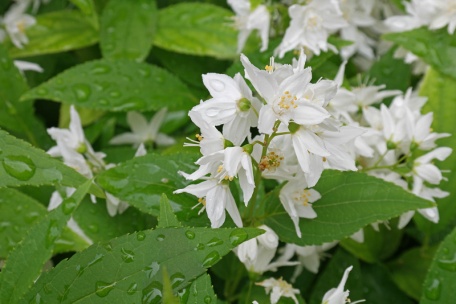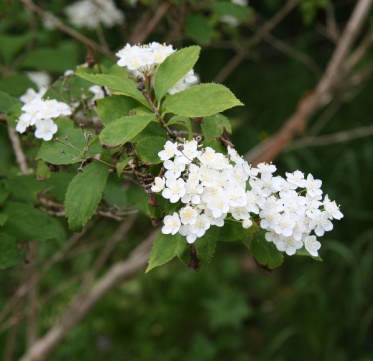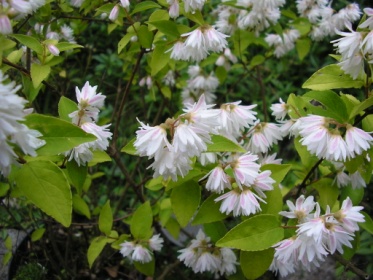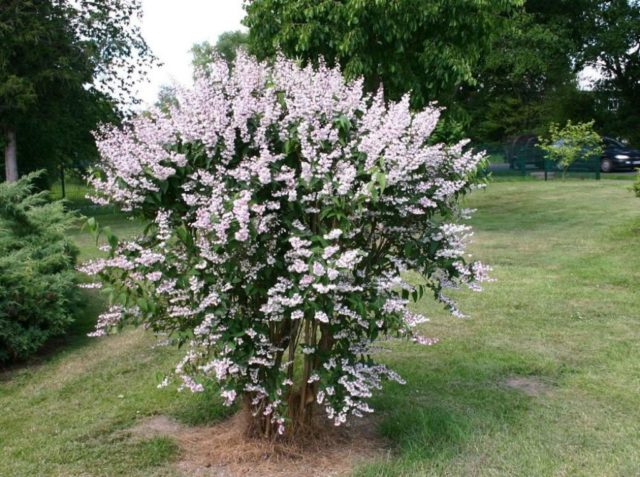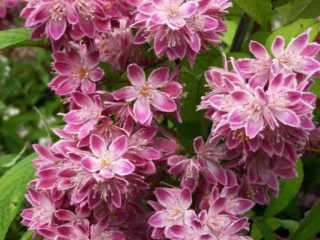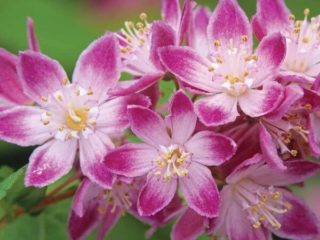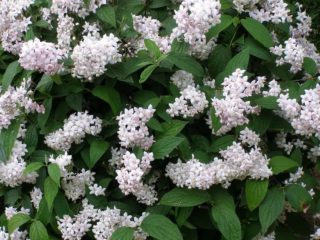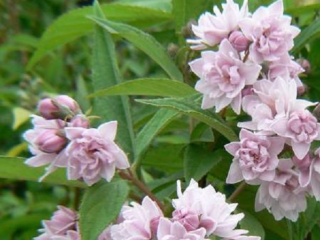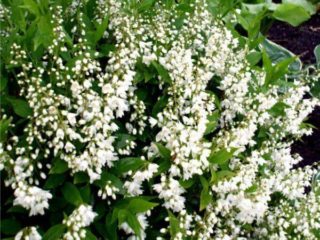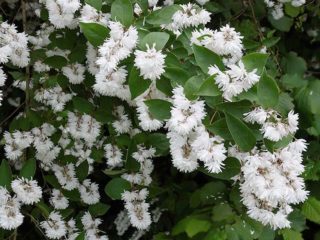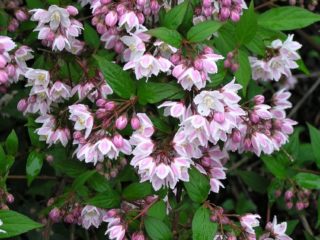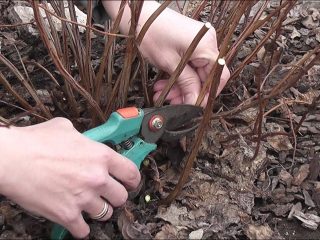Content
- 1 Is it possible to grow deutia in the Moscow region and central Russia?
- 2 Deutzia varieties for the Moscow region
- 3 Deutzia varieties for the middle zone
- 4 Rules for planting action in the Moscow region and the middle zone
- 5 Features of growing deutia in the regions
- 6 Pests and diseases
- 7 Conclusion
- 8 Reviews
Planting and caring for action in the Moscow region is an activity for experienced gardeners. The ornamental shrub comes from the east, but in the vastness of Russia it has taken root well and gained wide popularity. It is able to demonstrate all its lush beauty with proper care, but even without it it looks picturesque.
Is it possible to grow deutia in the Moscow region and central Russia?
For central Russia and the Moscow region, special varieties of deutzia have been bred that can withstand long frosty winters. Unpretentious bushes can grow even without pruning in one place for up to 25 years or more. In gardens they are planted next to lilacs and conifers. Lilacs differ in terms of flowering, which allows you to get a beautiful effect of transition from one type of flower to another. The delicate shades of deutzia green, changing into bright yellow and crimson tones in the fall, provide a picturesque but soft color contrast with the pine needles, giving the flower beds a special sophistication.
Deutzia varieties for the Moscow region
Among the varieties of deutzia that have proven themselves in cultivation in the Moscow region, it is worth especially noting the following:
- Deutzia gracilis – there are evergreen and deciduous varieties, but only the second variety is suitable for the Moscow region. The bush is about 70 cm high, depending on the variety, and has thin arched branches. The bloom is lush white or pink, but lilac is also found. Begins in the second half of July and lasts up to 35 days. Inflorescences are racemose, up to 9 cm in length. The foliage is up to 6 cm in length, emerald in color, covered with star-shaped hairs on the front side, and by autumn it turns purple-cherry tones.
- Deutzia amurensis) or small-flowered - deciduous shrub with a spreading crown up to 2 m in height. Large leaves are slightly pubescent, rich green in summer, brown-yellow in autumn. Corymbose inflorescences reach 7 cm in diameter. Flowering usually begins in the second half of June and lasts up to 20 days. White flowers are almost devoid of aroma.
- Deutzia scabra or star-shaped, reaches a height of up to 2.5 m. The branches are covered with brown or red bark. The leaves, depending on the variety, are from 3 to 8 cm in length, covered on the front side with star-shaped hairs. Racemose pink or white inflorescences reach a length of 12 cm and are strewn with flowers that look like stars. Under their weight, the branches bend, acquiring a weeping shape. Flowering begins in early August and lasts up to 20 days.
Deutzia varieties for the middle zone
Less frosty winters in the regions of central Russia make it possible to plant more different varieties of deutzia. For example:
- Deytsia Vilmorina (D. vilmorinae) - one of the oldest garden varieties, cultivated in Europe since 1897. It reaches a height of 2 m.Young shoots are pubescent and covered with bright green foliage up to 6 cm long, while last year's shoots are easily distinguishable by their peeling brown bark. It blooms in June for about 20 days. White flowers up to 2.5 cm in diameter are collected in corymbose inflorescences. Winters well when covered with spruce branches and dry foliage.
- Deutzia Lemoine (D. x lemoinei) – a shrub up to 2 m high, characterized by good winter hardiness. Even a bush that is frozen in a dry, snowless winter quickly recovers. The gray-green lanceolate leaves reach 10 cm in length and are pubescent on the underside. In winter they turn pinkish, yellowish and brownish. This action in central Russia produces abundant root shoots. Last year's shoots are almost bare, arched with red-brown bark. Flowering continues from May to June. White flowers up to 2 cm in diameter are united in erect pyramidal panicles from 3 to 10 cm long, practically odorless.
- Deutzia rosea – obtained by crossing the purple and graceful varieties. A low-growing shade-tolerant bush does not grow higher than 1 m. Flowers up to 2 cm in diameter are bell-shaped in a soft pink or white shade, collected in multi-flowered short racemes. Planting and caring for Deutzia rosea in the Moscow region is contraindicated, since it only tolerates frosts down to -28 °C. Sharp-serrated, ovate-lanceolate, rough and wrinkled, dark green leaves up to 5 cm long are covered with star-shaped hairs. Flowering lasts from April to May.
Rules for planting action in the Moscow region and the middle zone
Since deutzia is moisture-loving, it is often planted in the Moscow region along reservoirs. The bush is also good for forming hedges and mixborders. Most hybrids prefer sunny places, but there are also shade-tolerant varieties.Therefore, the planting site should be selected individually for a specific variety of deutzia, on the recommendation of the planting material supplier.
Recommended timing
In the Moscow region, with its long spring and early autumn, planting is practiced exclusively in the first ten days of May. This time is enough for the seedling to take root in a new place.
In the middle zone, planting dates shift to the last ten days of April. At this time, the soil should warm up to + 5 °C. If spring is late, with prolonged frosts, then planting deutzia is postponed until early May.
A deutia seedling suitable for planting has well-formed but unburdened buds. Under favorable conditions, the bush should bloom in a new place.
Site selection and soil preparation
A spacious clearing about 2 m in diameter is allocated for the seedling. Over time it will grow, so it needs space. Closer planting of deutzia in the Moscow region is practiced with the intention of creating a hedge.
The location is chosen so that the bush is in the shade for part of the day. Flower beds near the house, near the fence, are suitable for this. Cold strong winds inhibit the growth of deutzia. But under the protection of the walls of the house or a high fence, she feels good.
Deytsia loves well-drained, loose soil. To do this, the soil removed from the planting hole is mixed with peat compost, humus, and river sand is added. The optimal soil reaction is slightly alkaline. If the reaction is acidic, then the soil is enriched with slaked lime (about 300 g is mixed with the soil mixture poured into the planting hole).
Landing algorithm
The optimal root length for seedlings with an open root system is 35-40 cm.If the planting material has longer roots, they are shortened. The survival rate is higher for deytia with a closed root system, which is less damaged during delivery to the site.
The optimal depth of the planting hole in the Moscow region is 50 cm. There should be at least 1 m of free space in all directions from it. A thin layer of broken brick, sand or fine gravel is poured onto the bottom for drainage. The seedling is placed vertically, and the roots are sprinkled with pre-prepared soil, to which 100 g of nitrophoska is added.
The root collar is placed flush with the ground level, or it is permissible to deepen it by 2 cm. Immediately after planting, the plant is watered. The stems are shortened, leaving up to 5 buds on each branch. The tree trunk circle must be sprinkled with a 5 cm thick layer of mulch.
Features of growing deutia in the regions
In general, the rules for caring for ornamental shrubs in the Moscow region and the middle zone do not differ, with the exception that only those varieties that can withstand the maximum sub-zero temperatures of a given region should be planted.
Watering
When using mulch, which is generously sprinkled on the trunk circles, there is no need to water the deutia too often in the Moscow region. It is quite enough to water once a week during the growing season. Up to 10 liters are poured under each bush.
If precipitation occurs regularly in a given area, then you can do without artificial irrigation at all.
Fertilizing and mulching
During the season in the Moscow region, fertilizing is carried out once a month, that is, 4-5 of them will be required in total.Manure, which is diluted with water to a liquid state, is optimal. 3-4 liters are poured under each deutzia bush. Complex mineral fertilizing is recommended no more than 2 times per season - before flowering and at the end of summer. A portion of 100-120 g is added to one plant.
Mulch makes it easier to care for deytsia in the Moscow region. It retains moisture and prevents it from evaporating too quickly. Weeds will not break through a 5 cm layer. When watering, mulched soil compacts less, so it needs to be loosened much less often. The mulch left over for the winter will prevent the roots and shoots from freezing.
Pruning rules and preparation for winter
Snow alone is not enough to reliably prepare the action for wintering in the Moscow region and protect it from freezing. It is necessary to create an air-dry shelter. To do this, immediately after the leaves fall, the branches are bent to the ground and tied. Dry leaves with spruce branches are thrown on top, and then covered with film. This is what they do with young deutia bushes. Mature bushes are tied with twine and then covered with burlap.
Overwintering of the action in the Moscow region is preceded by its pruning. Young shoots of the current year are completely cut off. They will not bloom next season and are not needed by the plant. You can leave a section with 1-2 buds just in case. Old branches of the deutia are removed if they lead to excessive thickening of the crown. In the spring, pruning is repeated when all the buds have bloomed. At the same time, all branches that froze over the winter are removed. If the bush has suffered very badly over the winter, then it is given a rejuvenating pruning “to the stump”, leaving a short above-ground part with several buds.
Pests and diseases
Among the many ornamental shrubs, deutia is perhaps distinguished by its best resistance to pests and diseases.If, nevertheless, the bush is affected by one or another pest, then it is treated with a solution of karbofos. If the recommended watering regime is followed, the bushes extremely rarely suffer from fungal diseases, but if they are detected, watering is reduced and treated with an antifungal drug.
Conclusion
Planting and caring for deytsia in the Moscow region is not so difficult, but the effort spent is more than repaid by the beauty of the lush inflorescences. The minimum life expectancy of a bush is 25 years. With regular feeding, pruning and insulation for the winter, every summer the deutzia will delight with its flowering, which is not inferior to the splendor of more familiar shrubs - lilac, honeysuckle.


